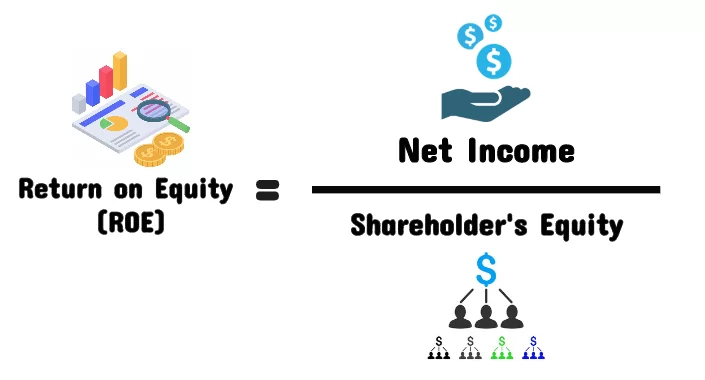Investing in companies that generate profits more efficiently than their rivals can be very profitable. Return on equity (ROE) can help investors distinguish between companies that are profit creators and those that are profit burners. If you are interested in knowing deep things about return on equity, then sit tight. We will take a full course on the return on equity formula, its calculator, and the best calculation method.
What is Return on Equity?
ROE essentially measures the rate of return that the owners of a company receive on their shareholdings. Return on equity signifies how good the company is in generating returns on the investment it received from its shareholders. Let us consider another close definition of that. Return on equity (ROE) is a financial ratio that tells you how much profit a public company earns compared to the net assets it holds. It is very useful for comparing the performance of similar companies in the same industry.
Overview
When the return on equity is used to compare one company to another similar type of company, that results in a more meaningful, more efficient, and more simple way of comparison. In corporate finance, the return on equity is a measure of the profitability of the business or organization in terms of equity. Return on equity is a measure of how smartly a company or organization uses its capital for investments to generate earnings growth that leads to profit for such an organization. Return on equity is a profitability ratio from the investor’s point of view, not from the company’s point of view.
ROE focuses on comparing a company to its competitors and the overall market. The formula is mostly beneficial when comparing firms in the same industry since it tends to give accurate indications of which companies are operating with greater financial efficiency and for the evaluation of nearly any company with primary material rather than immaterial.
Return on equity (ROE) is an important financial metric that investors can use to determine how profitable and efficient management is at utilizing equity financing provided by shareholders. It compares the net income to the equity of the firm. The higher the number, the better, but it is always important to measure apples to apples, meaning companies that operate in the same industry, as each industry has different characteristics that will alter their profits and use of financing.
As with all investment analysis, ROE is just one metric highlighting only a portion of a firm’s financial strengths. It is critical to use a variety of financial metrics to get a full understanding of a company’s financial health before investing.
Return on Equity Formula
ROE = Net Income / Shareholders’ Equity
The return on equity formula provides a simple metric for evaluating investment returns. By comparing a company’s ROE to the industry’s average, something may be pinpointed about the company’s competitive advantage. ROE may also provide insight into how the company management is using financing from equity to grow the business.
A sustainable and increasing ROE over time can mean a company is good at generating shareholder value because it knows how to reinvest its earnings wisely, to increase productivity and profits. In contrast, a declining ROE can mean that management is making poor decisions on reinvesting capital in unproductive assets. the only way to identify all of the above is through the return on equity formula.
Let’s break this down further.
Net income, also known as net profit, is on the income statement. It shows the total profit left over after the cost of goods sold, operating expenses, and any other expenses have been taken into account. It is often called the “bottom line” for that reason and because it can be found at the very bottom of the income statement.
Shareholder equity can be observed on the balance sheet. If your company were to liquidate all of its assets and pay off all liabilities, shareholder equity would be left. The balance sheet is set up to reflect the accounting equation (Assets – Liabilities = Shareholder Equity). To find shareholder equity, simply subtract liabilities from assets.
Return on Equity Calculator
A return on equity calculator was made to help you calculate ROE. This is a very popular and important indicator in business that shows how efficient the company is. There are some reputable calculators that can help one to calculate return on equity.
Omni calculator: Some men want to watch the world burn and others want to offer easily customizable embedded calculators. Mateusz Mucha belongs to the latter camp. Mucha is the founder of Omni calculator. His product lets you create your own custom calculators and currently supports several helpful formulas.
The mobile app has 270,000 monthly active users and he’s seen 8,500 weekly users on the website. With the Omni calculator, your return on equity calculation is solved.
BDC Ca.: This is another prominent calculator that helps to calculate return on equity. This business calculator will help you to calculate your monthly payments and the interest cost for financing your project.
Return on equity calculation
Below is an example of return on equity calculation.
Suppose that two firms have the same amount of assets ($1,000) and the same net income ($120) but different levels of debt.
Firm A has $500 in debt and therefore $500 in shareholders’ equity ($1,000 – $500). While Firm B has $200 in debt and $800 in shareholders’ equity ($1,000 – $200). Firm A shows an ROE of 24% ($120/$500) while Firm B, with less debt, shows an ROE of 15% ($120/$800). As ROE equals net income divided by the equity figure, Firm A, the higher-debt firm, shows the highest return on equity.
Firm A looks as though it has higher profitability when it really just has more demanding obligations to its creditors. Its higher ROE may, therefore, be simply a mask of future problems.
Limitations of ROE
While helpful, ROE should not be the only metric used to checkmate a company’s financial health and prospects. When taken alone, there are several ways that the ROE calculation can be misleading.
A company that aggressively borrows money, for instance, would artificially increase its ROE because any debt it takes on lowers the denominator of the ROE equation. Without context, this might give potential investors a misguided impression of the company’s efficiency. This can be a particular concern for fast-expanding growth companies, like many startups.
Similarly, if a company has had several years of losses, which would reduce shareholder equity, a suddenly profitable year could give it a high ROE, simply because its asset-based denominator has shrunk so much. However, the company’s underlying financial health would not have improved, meaning the company might not have suddenly become a good investment.
Do Equity LifeStyle Properties Have A Good Return On Equity?
Comparing a company’s return on equity (ROE) to the industry average is, in all likelihood, the simplest way to evaluate an ROE. However, due to the fact that businesses within the same industry categorization might vary quite a bit from one another, this method is only effective as a preliminary examination. As can be seen in the image that follows, Equity LifeStyle Properties has a return on equity that is greater than the industry standard of 5.1% which applies to REITs.
How Does Debt Impact ROE?
To increase their levels of profitability, the vast majority of businesses require additional capital. The money needed for investments can come from profits from the previous year (known as retained earnings), through the sale of additional shares, or from borrowing money. In the first and second scenarios, the ROE will be calculated taking into account the cash that was used for investments in the company. In the second scenario, the use of debt to finance growth will result in increased returns without having an impact on the overall equity. This will make the ROE look better than it would have if there had been no usage of debt.
What are the Negative aspects of the ROE
Share buybacks are another factor that might skew the return on equity ratio in the wrong direction. The number of shares that are now outstanding can be made lower when management makes acquisitions in the open market to repurchase their own shares. As a result, ROE will increase when the denominator is reduced.
One such shortcoming is that certain ROE calculations may not take into account intangible assets as part of shareholders’ equity. Intangible assets are anything that cannot be converted into monetary value, such as a company’s goodwill, trademarks, copyrights, or patents. This might lead to misleading computations and make it impossible to compare results to those of other companies that have made the decision to include intangible assets.
Last but not least, the ratio has a few different permutations when it comes to its makeup, and analysts may have different opinions regarding it. For instance, the shareholders’ equity can be the beginning figure, the ending number, or the average of the two, while the Net Income can be replaced for EBITDA and EBIT, and it can be adjusted for non-recurring items or it can be left unadjusted.
Can the ROE of a company be in the negative values?
Yes. The ROE of a company can be so low that it falls in the negative digits. Usually, investors don’t calculate ROE for firms with negative net income, as the return for such companies is zero. However, sometimes it so happens that the firm has negative shareholder equity due to liabilities that exceed assets at the time of positive net income returns. In a case like that, the ROE derived using the formula will be a negative value.
It is crucial to note that after the return on equity calculation a negative result doesn’t mean that you should disregard the company altogether. However, it should be a warning for you to go ahead with great caution. In typical scenarios, a negative ROE would signify that the company has problems with debt, asset retention or both. The negative ROE could be as a result of the company’s business development initiatives. When the company takes out a significant debt to launch an ambitious new project, it might end up with a negative ROE if the borrowed money is more than the company’s worth.
With a good understanding of precisely what is meant by “return on equity,” you can try making investments that work in your favor. You must also note that no single metric, even with the use of the return on equity formula, can provide a perfect tool for examining fundamentals. It’s not a foolproof or guaranteed way to tell whether you should invest in a company or not. But one way to do that is by contrasting the five-year average ROEs within a specific industrial sector.
What Does Return on Equity Tell You?
What determines whether an ROE is considered good or bad is what is considered normal among a stock’s peers. Utilities, for example, have a lot of assets and debt on their balance sheet compared to a little amount of net income. In the utility business, a typical return on investment (ROI) could be as low as 10%. A technological or retail company with smaller balance sheet accounts relative to net income may have a normal ROE of 18% or higher.
A decent rule of thumb is to aim for a return on equity (ROE) that is equal to or slightly higher than the industry average. Assume that a business, TechCo, has maintained a consistent ROE of 18 percent for the last few years. Compared to the 15 percent average of its rivals. An investor might conclude that TechCo’s management is above average at generating profits from the company’s assets.
ROE ratios that are relatively high or low will differ dramatically from one industrial group or sector to the next. Even yet, a typical investor shortcut is to see a return on equity approaching the long-term average of the S&P 500 (14%), as acceptable, and anything less than 10% as terrible.
How Does the Return on Equity Differ From the Return on Capital?
Return on capital, sometimes known as ROC, is another ratio that is frequently used to evaluate businesses. There are a few different formulations for this, but one of them involves dividing the net operating profit after taxes by the invested capital. If you calculate your income using your operational profit after taxes rather than your net income, all gains from the sale of assets or interest on loans are eliminated.
The book value of the owner’s equity is what the ROC uses to determine the amount of capital available. This includes liabilities but excludes cash. The ROC calculates how much profit is being generated by the operations of the business by excluding non-operating income and cash assets from the calculation.
FAQ
Why is return on equity important?
Return on equity gives investors a sense of how good a company is at making money. This metric is especially useful when comparing two stocks in the same industry. For example, if an investor was comparing two similar real estate stocks, some of their metrics may be industry-reflective.
How can I improve my ROE?
Improve ROE by Increasing Profit Margins
- Raise the price of the product.
- Negotiate with suppliers or change your packaging to reduce the cost of goods sold.
- Reduce your labor costs.
- Reduce operating expenses.
- Any combination of these approaches.
What causes a decrease in return on equity?
The big factor that separates ROE and ROA is financial leverage or debt. … But since equity equals assets minus total debt, a company decreases its equity by increasing debt. In other words, when debt increases, equity shrinks, and since equity is the ROE’s denominator, ROE, in turn, gets a boost.






